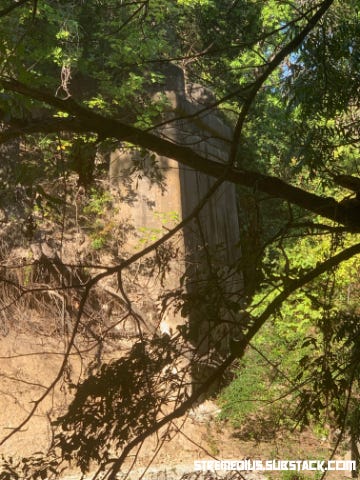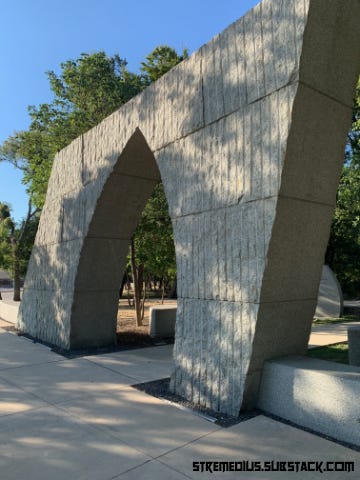St. Remedius Medical College: "Better In the Concrete Than In the Abstract"
Power Webs and Emergency Portals, All In Plain Sight
(Who was St. Remedius? And why is a medical college named after him?)
For self-taught experts on mysticism, the explanation for St. Remedius Medical College relocating from the French Alps to Dallas, Texas at the turn of the Twentieth Century involved its long history in the metaphysical arts. This included elaborate rationalizations involving ley lines, astrological confluences, and so-called “spell funnels,” all making its current location a particularly auspicious site for all sorts of magical experimentation and containment. Some even argued that the site had been used in the past for all sorts of forbidden and blasphemous magicks, with St. Remedius conjurors somehow tapping into a long-hidden source of sour and suppurating thaumaturgical power that would soon reflect back on its supposed masters and blast the area into raw chaos.
This, of course, was somewhere between bullshit and codswallop, leaning dangerously toward tomfoolery. The chunk of continental crust comprising the bulk of North Texas had not supported any significant amount of exotropic energy since the mid-Pennsylvanian Period, approximately 300 million years BCE., and by the present day was completely inert. No ley lines, no mystical artifacts, no cursed rites. Dallas had been chosen, in fact, specifically because absolutely nothing of significance happened there, occult-wise, since the site was beachfront property at the end of the Cretaceous Period. On a magical level, with one significant exception to the west, it was as flat and featureless as its terrain.
The reason why the Dallas area was so important lay with collection, distribution, and discharge of exonormal energies, from any source necessary. Over the Twentieth Century and the first quarter of the Twenty-First, Dallas was carefully overlaid with plinths, monoliths, arches, and statuary intended to capture even the slightest bit of escaping magical, exotropic, holoptronic, and psychotronic energies coming from space, seeping from within the earth, or being utilized by residents and visitors. Downtown Dallas’s famed collection of outdoor corporate art, as with innumerable pieces leased to businesses and other institutions, combine to capture and store these energies and transmit them for uses of intelligence, defense, and very occasional war. Monoliths and pyramids hidden along creek and river beds combine with new displays to gather energies that would take centuries or even millions of years to accumulate under normal circumstances, often in plain sight of the multitudes whose daily lives contribute psionic or vowelistic power to the great St. Remedius net.
The power net worked on multiple levels, too. Besides moving power for St. Remedius purposes, the web also acted as an early warning system for entities either tapped into or feeding upon said energies, giving personnel time to mobilize a response or stop an experiment before Something broke through, turned on, or started to breed. It also allowed a passive tracking system for any number of mystically-connected organisms, allowing the first reasonably accurate census of vampires by type in a major city (as can be expected by anyone familiar with local corporations, psychic vampires make up a significant proportion of the management in family-owned companies), and allowing the study of their habits when not feeding or sleeping. In some cases, this even allows conservation efforts for native and selectively introduced organisms, such as the herds of kelpies that went feral in Dallas in 1932 after accidentally escaping bonding to an exhibit at the World’s Fair that year. (Come across a pair of sandals or slippers at the water’s edge of a steep creek bank or otherwise inaccessible lake shore? Leave them alone and DO NOT TOUCH: kelpies have long memories, an extensive knowledge of Dallas’s hidden waterways, and a proclivity to inflict severe damage to sewer lines, where running everything in reverse is the least of the offender’s problems.)
An additional feature of the St. Remedius power net was that it was calibrated solely for use by authorized personnel, preventing misguided, deluded, or dangerously dysfunctional individuals from tapping it for malevolent or simply selfish intent. Any “unwatched nexuses” coming from cemeteries, parks, and other “power centers” were carefully constructed and monitored by St. Remedius, both to ensure that the energies being accessed were not used for dangerous or simply annoying purposes and to mark those individuals for further scanning. 99 percent of the time, the individuals were wildly deluded about their abilities and refusing to be tested and audited by a third-party mystical evaluator such as the Zwinge Foundation, but were too unfocused or just plain lazy to be a significant danger. However, a major incident in the summer of 1982 involving escapees from a local Renaissance Faire and a previously unknown artifact of extreme power was only prevented from turning most of North America into the galaxy’s largest ramjet because the power net picked up its transport into Dallas long before final insertion and hatching.
One final function of the St. Remedius power net only revealed itself to outsiders when the entire college disappeared. Known only to senior staff, many of the pieces of corporate art also acted as gateways in an emergency. Known as “Code Hatchback,” at a predetermined signal, all personnel and students were to move to the nearest gate, receiving further instructions after entry. Subsequent research into the power net showed that they all converged on one locale in the Oak Lawn area, previously the site of a goth club named “Vortex.” Since the site had been empty since the club shut down at the end of 1989 and the entire building razed after a fire in 1993, why this locale was so important is still unknown.
Related Reading
Stone Circles: A Modern Builder’s Guide to the Megalithic Revival by Rob Roy (Chelsea Green Publishing, 1999)
The Megalithic European: The 21st Century Traveller in Prehistoric Europe by Julian Cope (Element, 2004)
The Minbar of Saladin: Reconstructing a Jewel of Islamic Art edited by Lynette Singer (Thames & Hudson, 2008)
Want more hints as to the history of St. Remedius Medical College? Check out Backstories and Fragments. Want to get caught up on the St. Remedius story so far? Check out the main archive. Want to forget all of that and look at cat pictures from a beast who dreams of his own OnlyFans for his birthday? Check out Mandatory Parker. And feel free to pass on word far and wide: the more, the merrier.









